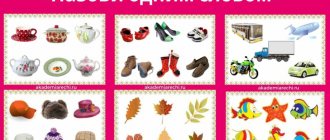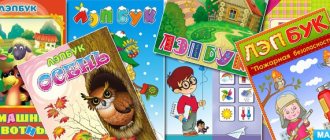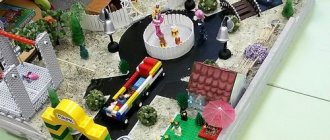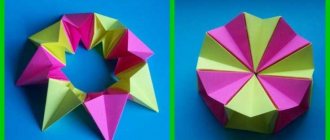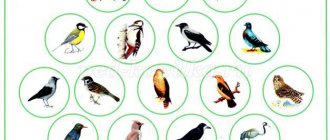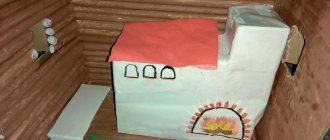On the topic: methodological developments, presentations and notes
The methodological manual promotes the development of mental processes of memory, attention, and perception of the thought processes of preschoolers. Formation of a holistic picture of the world, development of fine motor skills, sensory.
Musical and didactic games occupy a special place in the musical development of a preschooler. The proposed games are aimed at developing the perception of music, the development of vocal singing, and spatial orientation.
Consultation for educators.
1. Reasons for delayed speech development in children. 2. Tasks. 3. Examples of finger games.
Consultation for educators.
CONSULTATION FOR TEACHERS on the innovative activities of a music director on the topic: “The use of art therapeutic methods and technologies in .
One of the important tasks of the comprehensive development of a child is the education of musical culture. Its foundations are laid in childhood. In this regard, a large place is given to music in kindergartens, &nda.
Discussions.
DIY musical instruments for kindergarten
Here are several small master classes on creating interesting and unique musical instruments. You'll see, everything ingenious is very simple.
Drum
Any metal or plastic can that is hollow inside can become a drum. You are unlikely to find such children in kindergarten. But you can ask your parents to bring old plastic jars for mayonnaise, jam or shish kebab. For a variety of sounds, you can take cans of different sizes and wall thicknesses.
Absolutely any will also work as sticks. It is important that the tree (if you choose it) cannot injure children’s hands, that is, it should be coated with a special varnish. For example, chopsticks intended for eating Japanese dishes can play this role.
Wooden xylophone
DIY musical instruments for kindergarten are made from a variety of materials! If you have extra plinth, you can even make a tool out of it. It is enough to cut it into equal sections 10-15 cm long and screw it loosely to the base daughter with screws. The base must be treated so that children do not get splinters. The plinth pieces are placed in the same position one below the other.
To extract sound from this handmade musical instrument, a child moves any wooden stick from top to bottom. The more solid the stick, the louder and richer the sound will be produced.
Gusli
The basis can be a shoe box, in the lid of which a circle is carefully cut out slightly offset from the center. Rubber bands for money are wrapped around it or screwed so that all the “strings” pass over the hole. To prevent the rubber bands from lying on the surface and making sound, they need to be supported with something.
A pencil can serve as a support. However, if you want to raise the “strings” higher, then it is better to make a triangular structure with your own hands, because, as you know, it is the most reliable. Now you can play.
Cugicle
This wind instrument is made from ordinary straws, which are usually offered to children for drinks. It is better not to take those tubes that are attached to juices, since they are small and have a spring for bending in the most inappropriate place. And so, take several tubes of the same diameter (they can be replaced with anything: “cases” for pens, balloon sticks, etc.).
Then, from one of the edges, the second tube is sawed off from below by 1-1.5 cm. The third tube is sawed off to double the distance. Each subsequent one is sawn off in the same way so that a kind of uniform ladder is obtained. Then take a wide tape and place the tubes on it exactly along the edge, one next to the other. Then you need to tape it on the back side.
If your musical instrument is large, then it is better to first cover 2-3 tubes separately with small tape, and only then all together. The lower holes of the musical instrument with your own hands for kindergarten need to be closed. This can be done with plasticine, cut pieces of eraser, or even chewing gum.
Analogue of a triangle
To recreate the subtle sound of a metal stick touching another metal object suspended in the air, you can take the idea from this musical instrument. To make it, you will need 2 metal tubes, one of which will be suspended from any improvised handle by strong threads. The other child will hit and make a pleasant sound.
Maracas
To make your own maracas for kindergarten, any hollow oblong container that can be filled with granules, cereals or larger objects can be suitable. The easiest option is to take a simple pencil, pierce it through a plastic egg from Kinder Surprise and secure it. Peas or rice are placed inside, depending on the desired sound output.
Another option is 0.5 ml plastic bottles. You can put unnecessary buttons or the same cereal inside. Of course, to make the musical instrument look realistic, the bottles should be painted, preferably with acrylic paint to be sure. You can do something different with filled plastic eggs: take small plastic spoons and place them on both sides so that the tips of the base touch. In principle, spoons can be placed on glue, but for beauty, they can be covered with colored tape around the perimeter.
The musical instruments that children make for kindergarten with their own hands will allow them to learn to improvise with sounds and understand the world through play. After all, even in a store, children are more attracted to those toys that can make some sounds, words, or light up. Remember that almost everything that surrounds us can become a musical instrument.
For example, let's take a regular empty cardboard box. It is enough to knock on it with your hands or sticks - and it is already a drum. Anything that can be filled with something and moved from side to side is a potential maracas. DIY musical instruments for kindergarten are a potential source of individual sounds for staging fairy tales. A loud knock - a clap of thunder or the roar of a wild animal. The paper rustles - it’s the wind blowing or autumn leaves falling. Music is all around us.
